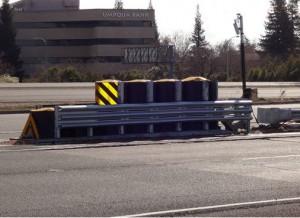
Self-Contained Traffic Hazard Monitoring
| Outcome | Expand the utilization of self-contained vision based sensor systems which can easily be configured and deployed to monitor a wide range highway sites. |
| Benefit | Provide Caltrans traffic engineers with an automated web-based traffic monitoring device to assist in the study and mitigation of hazardous highway traffic locations. |
Driver Behavior
Incidents
AHMCT researchers have developed, deployed, and currently maintain several self-contained vision based sensor systems which autonomously monitor hazardous highway locations. These devices provide web-based access to both live video and recordings of past incidents trigged by configurable events. These sensors were originally developed to collect highway crash attenuator impact data and have been on-line monitoring vehicle traffic incidents for over a year and half. The monitoring device is an ideal tool for the collection of traffic incidence data which would be useful for the assessment and mitigation of hazardous highway locations.
Crash Attenuator Monitoring
The sensor monitoring device features vision motion detection in a configurable active field of view. Detected motion triggers the camera to store video clips which are remotely accessed and downloaded over the web. The attenuator sensor also contains a powerful integrated microcontroller and multi-axis accelerometer sensor providing enhanced camera triggering capabilities. An integrated cellular modem provides user configurable notification mechanisms (either text messaging or email) that can be changed through the web.
Attenuator Monitoring- I80Bus Hwy 160 Split
Three sensor systems are currently deployed on mainline highways. Between June 2012 and Jan. 2014, videos of 10 attenuator vehicle strikes were captured consisting primarily of nuisance impacts of which Caltrans would have otherwise been unaware of. This information was being collected for an in-service attenuator life cycle cost study and provides hard data relating to impact frequency, magnitude and maintenance costs on the highway.
Traffic Hazard Monitoring Tool
The attenuator study sensor device is a highly flexible video monitoring system that can be adapted to a wide range of highway situations. Since the microcontroller can be easily configured with a wide range of sensors, the system can be furthered tailored to meet the specific needs of most location.
During the course of attenuator monitoring, a re-occurring traffic issue was exposed with the sensor device. Vehicles entering Hwy 160 from Arden Road southbound were recorded dangerously crossing 2 lanes of Hwy 160 traffic to cut-over to I80BUS westbound. The green path in diagram below indicates the designed route; the red path illustrates the hazard.
Identified Traffic Hazard – I80BUS Hwy 160 Split
The red path in the following image shows the hazardous path from the highway perspective. The image of a truck cutting across this hazardous path in traffic is an image taken from a video clip captured by the attenuator monitoring device during normal traffic flow. At this site, the sensor system information was able to identify a clear risk to the general public.
I 80Bus Traffic Hazard Route Truck Cross-over
Presented to Caltrans Maintenance a channelizing system was determined to be the best mitigation. Plastic delineators were installed to further discourage the unsafe driving behavior (Shown Below). The net result is a safer highway interchange. This change could quite possibly prevent a deadly accident from occurring in the future.
Site mitigation upgrade Installed dilineators
Safety Benefit
As illustrated earlier, a lot of insight about a location’s traffic dynamics can be gained by direct monitoring. This insight would help to develop a mitigation plan. Once a plan was implemented, the site can be monitored again to assess the effectiveness of the implemented solution. Certain highway locations are dangerous. This process would reduce the associated inherent danger through a careful site review. Problematic sites could be identified through the use of various state databases such as the TASAS database or from requests by various people within CALTRANS.
Solar Power Option
The original sensor system required external power. Based on the experience gained in the field with the first 3 units, the power consumption of the system could be significantly reduced. This was further enhanced by modifying the microcontroller hardware and software to employ various power conservation measures. The net result was the development of a viable solar powered system.
The solar powered system opens up more sites to possible instrumentation. Additionally, this means that the installation process is much easier as fewer changes are required to the local infrastructure. An image of the solar unit is given below.
INSERT Solar-Sensor2-181x300.jpg
Solar Power Option
Summary
Sensor device design emphasizes portability and flexibility. The sensor monitoring devices could easily be moved from site to site with minimal effort. The sensor’s firmware is easily configurable on a case by case basis. The current system is easily adaptable to guardrail applications. Users may wish to rely on the vision system alone. However, a wide range of plug and play sensors can be integrated into the microcontroller yielding more concise data. The Data is accessed over the web. Minimal training is required in order to sort the data. This process would involve looking for anomalies in the data and then presenting any finding to traffic operations and maintenance for evaluation. Finally, as the devices are implemented at various sites using different configurations, a new toolbox would be built to help improve the road by improving the safety of the motoring public.
For Additional Information
| Vue Her Caltrans Project Manager | vue.her@dot.ca.gov | (916) 227-5828 |
| Steve Velinsky Principal Investigator | savelinsky (at) ucdavis.edu | (530) 752-4166 |
| Duane Bennett Primary Contact | dabennett@ucdavis.edu | (530) 752-4473 |
This document is disseminated in the interest of information exchange. The contents do not necessarily reflect the official views or policies of the AHMCT Research Center, the University of California, the State of California, or the Federal Highway Administration. This document does not constitute a standard, specification, regulation, or imply endorsement of the conclusions or recommendations.
(rev. Oct 2015)
